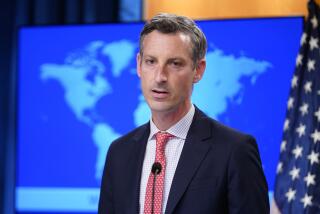Soviets OK Limited On-Site Inspections : Offer on Troop Moves Seen as Breakthrough in East-West Talks
- Share via
STOCKHOLM — The Soviet Union told the 35-nation Stockholm security conference Tuesday that it is prepared to accept limited mandatory on-site military inspections, a decision that was seen as a breakthrough on a longstanding controversial East-West issue.
“We could . . . agree to the conduct of on-site inspections,” Soviet Ambassador Oleg A. Grinevsky said at the start of the final session of the 32-month-old talks, known formally as the Conference on Confidence and Security Building Measures and Disarmament In Europe.
The aim of the conference is to agree on measures to lessen the risk of war in Europe. It brings together the United States, Canada and all European countries except Albania.
Grinevsky and U.S. chief delegate Robert L. Barry agreed in opening statements Tuesday that a document should be ready for the session’s Sept. 19 deadline. Barry expressed hopes for an “comprehensive agreement.”
In Washington, State Department deputy spokesman Charles Redman said the United States welcomes Grinevsky’s public acknowledgment that on-site inspection of troop movements and other military activities is an essential component of any agreement.
Must Be Part of Agreement
“The United States and its allies have maintained that an effective verification regime, including on-site inspection, must be an integral part of any Stockholm agreement,” he said.
A Western diplomat said a Soviet turnaround on the on-site control issue could have “heavy implications” for other East-West disarmament talks and could be meant to lend impetus to such talks.
But Grinevsky, later at a news conference, said the initial U.S. rejection Monday of Soviet leader Mikhail S. Gorbachev’s call for a joint nuclear test moratorium could hamper East-West relations.
Grinevsky said that if Gorbachev’s proposal was rejected because it was considered Soviet propaganda, it would be “extremely negative for all international life, the Soviet-U.S. bilateral relations and all possible movement forward in any talks.”
The Western delegate, who spoke on condition of anonymity, said the Soviet policy change on mandatory on-site inspections indicated a new “openness” on the issue of military activities.
Check on Troop Movements
On-site inspection proposals advanced at the conference specified that one country could demand access to another’s territory, on a limited quota basis, to check on unannounced troop movements.
Grinevsky told the news conference that the Soviet Union would not refuse inspections under such an agreement.
“Until the quota has been used up, we would have to accept them,” he said.
When the conference opened in January, 1984, then-Soviet Foreign Minister Andrei A. Gromyko, now the Soviet president, said that demands for on-site inspection were only “an excuse to peek through the neighbor’s fence.”
Grinevsky told the news conference the Soviets would be prepared to accept one or two mandatory inspections per year, but he rejected proposals that all troop movements outside of garrisons would be open to checks.
“By all the logic, inspection should cover such concrete types of notifiable military activities as maneuvers, movements and transfers of forces,” Grinevsky said.
The issue of notification of troop maneuvers remains unsolved, despite the increasing atmosphere of optimism that has prevailed since the close of the last conference July 18, when both North Atlantic Treaty Organization and Warsaw Pact countries proposed compromises.
The Soviet Union has agreed in principle to notification of maneuvers involving more than 18,000 soldiers, but the West hopes to set a lower limit of 6,000 troops.
The conference had been stalled during a major freeze in superpower relations. It gained momentum at the end of the last session in July with East-West agreement on notification involving military air activities, removing a main stumbling block in the talks.
More to Read
Sign up for Essential California
The most important California stories and recommendations in your inbox every morning.
You may occasionally receive promotional content from the Los Angeles Times.









